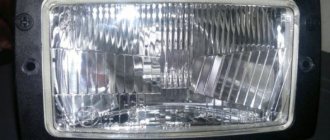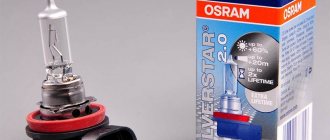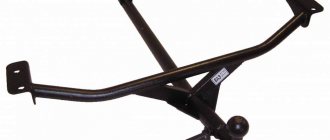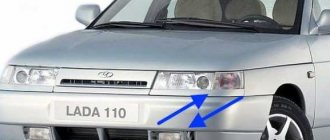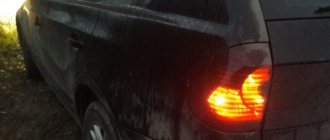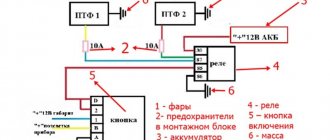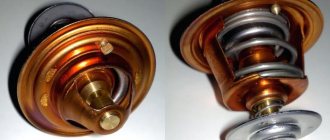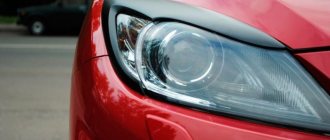When purchasing headlights, an auto parts store offers a huge variety of fog components in different formats and sizes. GOST 8769-75 forces VAZ-2110 drivers to control themselves and install headlights that meet certain legal requirements:
- You cannot install just one fog light; fixation involves installing a kit consisting of 2 parts.
- If you measure the distance from the side marker, the headlight is in 400 mm increments, and the measurements are taken along the outside of the diffuser.
- The step from the road surface to the bottom edge to the dissipative product cannot be less than 150 mm.
- It is not permissible to install headlights higher than the headlight.
To install the PTF, you must purchase in advance the entire set of materials and tools:
- A set of fog lights, note that the VAZ-2110 dashboard is an older model, so the headlights for Euro models should be put aside.
- Lamp for monitoring the procedure.
- A multimeter that allows you to test the correctness of individual stages of work.
- Double connectors, among experts they are also called “mother and father”, 1 set is enough.
- 8 pieces of female connectors.
- Insulating tape.
- Packaging material for heat shrinking.
To correctly install fog lights on a VAZ-2110, you need to start from the electrical diagram; it can be taken from KGPTF.
Expert opinion
It-Technology, Electrical power and electronics specialist
Ask questions to the “Specialist for modernization of energy generation systems”
Where do the fog lights turn on on a VAZ 2110? Auto repair Only fog lights specially designed for the VAZ 2110 can be installed on a car without any body work. Ask, I'm in touch!
The problem with new headlights
It happens that after installing new headlights, purchased for a lot of money from a reliable, excellent manufacturer, the quality of the glow leaves much to be desired.
Inexperienced drivers attribute everything to a defect or the purchase of a fake disguised as a trusted company. But in reality everything is completely different.
Headlights shine efficiently and efficiently not only depending on the manufacturer. Settings that someone doesn’t know about or simply forgets play a big role.
Headlights that have just been removed from the factory packaging and installed in place of the old optics do not have the adjustment required specifically for your car. You can do it yourself, but this will require a perfectly flat area, a similar wall and the skills of a draftsman. In practice, this is quite difficult to implement, so the optimal solution is to entrust the adjustment to specialists from a service station.
Alas, the VAZ 2110 is not a modern, advanced car in which the headlights are automatically adjusted electronically. Here everything has to be done manually.
Basic operating principle of electrical equipment
Note. It should be noted that the general principle of operation of electrical equipment on all VAZ families is identical.
- absolutely all electronic devices of the car are connected according to the principle of a single-wire circuit;
VAZ 2110 wiring diagram
- the car body acts as a negative wire;
- all consumer terminals, together with power sources, have a direct connection to the car body.
Note. All electrical wiring wires have a strictly defined color, which is indicated in the diagram by the first letter of the name of the corresponding word.
The power wire is always marked in red in all diagrams and is designated by the letter “P”, since it supplies power to the positive terminal of the battery.
VAZ 2110 do-it-yourself installation of fog lights
How to install and connect fog lights with your own hands
Car tuning is a fashionable concept and every car enthusiast wants to transform his car in any way. Domestic cars are no exception. If you decide to carry out external tuning of the VAZ 2110, then, for starters, installing fog lights for your VAZ 2110 car will be an excellent solution.
Fog lights are a useful thing, but domestic manufacturers rarely equip cars with them. In different companies, the cost of installing fog lights varies and ranges from 1.5 thousand rubles. up to 4 thousand rubles If you want to save money, you can install the fog lights yourself.
Installing fog lights on a VAZ 2110 car is not difficult, and in this article we will look at how you can do it yourself. The location for the fog lights will be under the bumper.
For type 10 models, there are two types of fog lights: corrugated, which scatter light, and transparent, which shine in spots and are considered more fashionable, although worse to use. To install headlights, purchase additional frames for headlights, a key, a key indicator (yellow), wires, relays, a ground terminal, a wide and narrow male terminal, a wide and narrow female terminal, and plastic blocks.
In connector Ш1 we find yellow and yellow and black wires. In the bundle from connector Ш1 we take 3 wires: yellow, yellow-black and thin yellow-black. Under the hood, disconnect the wires from the washer barrel and the liquid level sensor. Unscrew the nut that secures the washer barrel. We pull out the bundle of wires from under the left side member. We cut off 2 pieces of wire from the yellow wire and stretch them into the car interior. We strip the wires, crimp them with wide male terminals and insert them into the block so that the yellow-black wire joins the marked wire. We connect the block. We press the 2 yellow wires to the harness and put the washer barrels in place.
We cut off 2 pieces of wire 50 cm each, crimp the terminals to the ground of each wire and fasten it all on a stud together with the ground from the headlight. We stretch the fog lamp wire in the front side member. We pull both wires out at the place where the fog lights are mounted. A wide ground must be crimped onto each wire. We put brackets on the bumper, we put a block for the wide mother on the wires. Now you can prepare the headlights themselves. We insert light bulbs into them, but do not touch the light bulbs with your fingers, otherwise they will immediately burst when heated. Therefore, if you have already touched the light bulb, you need to degrease it. We connect the yellow wire to the light bulb, and the black wire to the body. We install the headlights. The installation of fog lights on the VAZ 2110 has been completed. This procedure takes about 1.5 hours. The installation of fog lights 2107 is radically different from 2110; a completely different connection scheme is used here.
Tuning VAZ » Tuning VAZ 2110
More news on the topic
Installing a voltmeter with your own hands on a VAZ 2106 Replacing a headlight on a VAZ 2110, 2111, 2112 We install mirror tuning on a GAZ 3110. Replacing a VAZ generator
Installation process
Before installing fog lights on a VAZ 2110, you should carefully consider purchasing them.
But don’t rush to the store, but first figure out what kind of front bumper your car is equipped with. If the bumper has seats for PTF (they are usually closed with plugs), then everything is in order. Measure your seats and go to the store.
If the installation of fog lights on your bumper is not provided, then you will either have to buy a new bumper or do it yourself. Here everything will depend on your desires and capabilities, since there are always PTFs on sale with decorative overlays that can be installed on almost any bumper.
In some modifications of bumpers there are no holes for fog lights, but the places for their installation are stamped. In this case, first select the headlights that will fit your bumper, and only then cut the mounting holes for them.
This can be done using a conventional drill by drilling a series of holes around the perimeter of the future seats.
After the hole is cut or the plugs are removed, install the PTFs in their places, following the instructions and using the fasteners included with the headlights. Typically, headlights are attached through a decorative trim using two screws.
Features of PTF (difference from headlights)
Installing parking sensors with your own hands
So, the main task of fog lights is to illuminate the road in poor visibility conditions (rain, snow, fog, etc.). However, unlike the head light, there are features.
First of all, PTFs must have the clearest possible upper cut-off line, and the beam of light must be strictly below and be as wide as possible. If these conditions are not met, this can become a problem both for the driver of the vehicle and for other road users driving in the oncoming lane.
We also note that even if the headlights have the most powerful lamp, the features, purpose and installation location of such headlights do not allow them to effectively illuminate the road in fog or rain.
The fact is that the head light should illuminate the road as far as possible, not blind oncoming drivers and cover the side of the road. However, in conditions of limited visibility, neither high nor low beam can cope with this task. The reason is that a powerful luminous flux is reflected from moisture particles, causing a cloudy “wall” to appear in front of the driver. This is especially noticeable when the high beams are turned on.
In turn, high-quality PTFs are characterized by lower power, and the optics themselves are made and installed so that the light from the fogs literally “breaks through” moisture and fog. The main secret is that usually the fog does not touch the ground, and the fog lights are as low as possible.
On the one hand, fog lights do not shine as brightly and far as the headlights, but in poor visibility conditions they illuminate several meters of the road in front of the car. The main thing is to follow the rules for installing PTF and setting up such optics.
In a nutshell, there are clear norms and standards that must be adhered to during installation. Additional adjustments allow you to set the fog lights so that the light flux falls on the road, does not blind the driver, does not form a “wall” in the fog in front of the car, etc.
At the same time, it is important to understand that cheap and low-quality PTFs, as well as incorrectly installed fog lights of a VAZ or any other car, will blind oncoming cars, but are not able to fully illuminate the road
For this reason, when selecting fogs, first of all, you need to pay special attention to this optics.
Why is this necessary?
Modern fog lights provide significantly more “penetrating” light through fog and rain and better illuminate the road surface. Firstly, PTFs produce a flatter luminous flux, spreading above the ground and spreading more in width than in height.
This was not done in vain. The fact is that due to the discrepancy in the temperature of the air and the ground (the ground is warmer), the fog rarely reaches the road itself, which means that with such headlights on the VAZ 2110 you will see the road you are driving on at least ten meters further ahead low beam headlights.
Secondly, due to the beam width of the fog lights, you will see the roadside and markings. This will prevent you from “flying off” the road, which is not uncommon in fog.
Thirdly, you will not blind oncoming cars, but you yourself will be visible to other road users, if, of course, the adjustment is made correctly. This means that the probability that another car will not crash into your VAZ 2110 increases.
Self-adjustment
How to make angel eyes headlights with your own hands
Having understood the features and found out the purpose of the fog lights, it’s time to start adjusting them. (See also the article How to install fog lights on a VAZ 2110: features.)
The instructions will look like this:
- Selecting a location and preparing markings;
- Direct adjustment.
Preparation:
- Place the car on a flat surface 3-5 meters from the wall, which will serve as a kind of stand;
- Measure a horizontal line on the wall, the height of which is equal to the height of the PTF installation on the car;
Marking a homemade screen for adjustment
- Set the headlight range control to position “0”;
- Then turn on the headlights and, alternately closing the left and right, mark the center of each of them on the wall (points “A” and “B” in the photo above).
Start adjusting:
- Using a screwdriver and an adjusting screw, ensure that the centers of the headlights are located at the same distance from each other;
- Then adjust their height - it should be 10 cm lower.
Adjustment process
This completes the adjustment process. A gap of 10 cm will allow the headlights not to blind the driver even when the car is fully loaded. (See also the article Installing a towbar on a VAZ 2115: features.)
Types of instrument panels and location of fog lamp buttons
As I noted above, depending on the modification, VAZ 2110 cars are equipped with two types of panels: the so-called old panel and the European panel. If you have a Europanel installed, then the place to install the button for turning on the fog lights is located to the left of the steering wheel, and this button is located in close proximity to the button for turning on the side lights.
On some modifications of the Europanel, the buttons for sidelights and fog lights may be located one above the other:
On a regular, old panel there is no special place for installing a PTF switch, but there are places for installing additional buttons for any purpose, including for connecting PTF. They are closed with plugs and are located on the switch panel between the driver and passenger.
On cars with an older panel, the space for additional buttons is located to the right of the driver
The indicated installation locations for the fog light switch on a VAZ are recommended, but not required. You can install the PTF button in any place convenient for you.
The principle of operation of the fog lamp
Before grabbing the tools and adjusting the position of the PTF on the car with your own hands, every car owner must understand the features of their operation.
And for this you need to remember that fog:
- These are the smallest particles of moisture that are in the air;
- The emanating heat from the ground (road surface) does not allow them to sink, causing them to literally hang, which leads to the formation of a milky veil;
- The stream of light, reflected from them like a mirror, returns back and blinds the driver.
Narrow work space
All drivers know that turning on regular headlights in fog leads to poor visibility. This happens because droplets of moisture are located exactly at the level of the headlight of a modern car. After all, their location was determined for better illumination of the road situation - as close as possible to the driver’s organs of vision.
But PTF has another task - to make movement in fog possible. That’s why they are installed on cars as low as possible to the road surface, so that they, as they say, “shine under the fog.”
Correctly adjusted PTF shines “under the fog”
The fact is that moist air close to the ground is drier and, accordingly, does not have glare properties.
Technical feature of the luminous flux
The second point that should be emphasized is that:
- The beam of the fog lights along the top edge has a clear boundary:
- This is done so that when it hits drops of moisture, it does not refract upward and blind drivers.
The peculiarity of PTF operation is the crossed upper limit
Roadside lighting
There is another feature of fog lights that is often forgotten.
After all, it is the same lighting device as the head light, i.e. must:
- Create sufficient visibility of the road situation for movement;
- And illuminate the side of the road to the right of the car in the direction of travel.
Both regular and fog lights should illuminate not only the road ahead, but also the right side of the road
Why are taillights bad?
The real fly in the ointment for the VAZ 2112 model was the work of the rear lights.
The reason for frequent refusals is trivial:
- the conductive tape in the flashlight body has poor contact;
- unstable contact and increased frequency of operation leads to lamp burnout;
- Despite the fact that their price is low, replacement will only help for a short time.
Warning! Unfortunately, replacing the conductive tape from the same manufacturer will also not solve the problem.
Conductive tape - a cheap part with a short life term
Legal requirements
Russian GOST
Currently, GOST 8769-75 regulates the installation and operation of external lighting devices on vehicles operated on public roads.
The photo shows the GOST section on the requirements for installing PTF
According to section 2.3 of the specified GOST, PTF can:
- installed on a passenger car only in pairs;
- located no higher than the headlights, but no lower than 25 cm from the road surface;
- do not protrude beyond the dimensions of the car, and at the same time, be located no further than 40 cm from the dimensions of the front fenders;
- shine the same light for each headlight.
UNECE
Since foreign-made vehicles are used in Russia and the CIS countries, the lighting devices installed on them are subject to UNECE requirements. Accordingly, the products of foreign manufacturers, in particular PTF kits for installation on the VAZ 2110, must meet the specified requirements.
According to UNECE requirements, the shape of the PTF light spot must have a clear vertical boundary (Figure B)
These rules also regulate the shape of the light spot for:
- low beam headlights with a regular or halogen lamp (in Figure A);
- low beam headlights with a gas-discharge light source (B in the figure).
Color meaning
Some people, in the old fashioned way, believe that it is better when the fog glass is yellow. But this is not true. Most leading manufacturers today produce transparent white fog lights, and they are not only as good as yellow ones, but often superior to them.
On the VAZ 2110 you can install corrugated or transparent glass. The latter are for some reason more fashionable, although less useful, since they shine in spots, while the corrugated ones give a more directed beam, which really increases visibility in bad weather.
Fog lights VAZ 2110 wiring diagram
Wiring diagram for fog lights.
connection option 1
1) Open the fuse box, then unscrew the screw, pull it out and turn the fuse box over. Wires marked in green do not come from the factory and must be added.
Reverse side of the fuse box.
2) From the bundle of wires included in the kit, cut off two wires, 15 centimeters each. At the ends of both wires we attach female connectors.
The red wire, marked 1 in Figure 2, is positive, you can even check it with a test light. We stretch it to the leg number thirty on the back of the relay.
We connect the first positive wire.
3) The wire labeled number 4 in the figure as 2 is the pole running from pin 87 back to the fuse box.
We connect the second positive wire.
4) We connect the red positive wires to the fuses in Figure 5 (they are intended for PTF), after which they separate one at a time to the right and left headlights.
Fuses for PTF (10 amps each) installed from the factory.
5) We mount the wires as shown in Figure 7. We attach thirty-centimeter wires with “mothers” at the ends to the double-female connector.
We create a convenient installation connection.
6) We insert the wires with single “mothers” into the white plug, in the places marked with circles on the fuse block.
Connection points for single females on the fuse block.
7) We remove the double female connector from the fuse block and connect it to the double male connector, which is located behind the trunk release button.
We connect our connector to the connector behind the trunk release button.
 The black wire numbered 3 comes from pin 86 located on the relay and is a minus. It is best to draw the negative from the top of the fuse block. There are already factory black wires there, inserted under the 10 nut. The wire marked with the number 4 is responsible for turning the PTF on and off.
The black wire numbered 3 comes from pin 86 located on the relay and is a minus. It is best to draw the negative from the top of the fuse block. There are already factory black wires there, inserted under the 10 nut. The wire marked with the number 4 is responsible for turning the PTF on and off.
Negative and PTF switching wire.
Several options for where to run the PTF control wire.
1) From the side lights directly, when the side lights are turned on, the PTF turns on.
2) From dimensions with an additional button. Then turning on the dimensions only supplies power to the button, and the button itself turns on the PTF.
3. We run the wire from the ignition switch through the button, as in method 2. This is the most convenient option.
In photo No. 11, number 1 indicates the PTF turn-on relay, and number 2 indicates the place for the electric lift relay. We take two wires from it, extend them and connect them to the headlight switch button
One of them (pink thin in our case) when you turn on the ignition, a “plus” will appear, and the black wire will be a “minus”. To correctly connect the PTF, it is important to know that the left output is located near the radiator, under the left headlight, and is easily secured with a clamp to the car body. The right exit is located symmetrically under the right headlight.
Direction indicators
The direction indicators (left or right) are activated by the steering column switch. The hazard warning mode (all direction indicators flash) is activated by pressing the corresponding button. The blinking of the lamps in this mode is ensured by a short-circuit breaker relay type 493.3747 in the mounting block. If one of the turn signal lamps burns out, the blinking frequency of the remaining lamps and the warning lamp doubles. In normal mode, the blinking frequency should be 90±30 cycles per minute at an ambient temperature of -40 to +65°C and a voltage of 10.8 to 15 V.
Basic misconceptions
Before giving comparative characteristics regarding certain lighting devices, it is necessary to clearly define the terms found in the automotive environment.
Lensed ones do not have a reflector
So, lensed headlights on the VAZ 2110 mean that the headlight itself has a lens (glass or plastic), which allows you to get a light beam from the smaller surface of the built-in reflector that is superior in power to the traditional one.
The instructions for branded products always contain information about the structure of the lensed headlight
In other words, a reflector (reflector) is an integral part of any headlight, since it is it that collects light into a single stream. But the lens is responsible for its direction, therefore, it is more correct to call such a headlight projection lighting technology.
The main advantage of lensed headlights is their compactness.
Fog lights can be installed in headlights
Another misconception that exists among car owners of the VAZ 2110 and other models of the Volzhsky Automobile Plant. It was formed due to the compactness of lensed headlights and their small dimensions, allowing them to be installed instead of standard lighting equipment.
Factory classic optics VAZ 2110
In fact, any lighting devices will not be effective when working in fog for one simple reason:
- the milk veil contains a high concentration of water droplets;
- they refract light, scatter it and reflect it back, blinding the driver.
This is why PTFs should be located below the standard headlights, because:
- warm air from the ground and road surface dries the air;
- the fog does not touch the surface and remains above it at a distance of 30-50 cm;
- It is in this narrow space that fog lights should work.
Fog lights should only shine yellow
The lenses installed in the headlights of the VAZ 2110 can shine in both white and traditional yellow. There is no violation here, since everything depends on the technical features of the installed lamps. (See also the article Relay for fog lights VAZ 2110: features.)
The photo shows a projection of the dispersion of the light flux. The difference in the illumination distance of high beams and PTF is shown
Xenon can only be installed in lensed headlights
The source of any light beam is lamps, even if we are talking about PTF or traditional head optics. There is also a lot of confusion and misconceptions in this issue, which we will now dispel:
Today, 4 types of lamps are used in headlights:
- traditional incandescent lamps;
- halogen;
- xenon;
- LED
More than 40 types and types of lamps are used in modern cars.
We will not dwell on their technical details, but will only note the fact that the standard for fog lights is lamps with H and HB sockets.
In other words, if, when purchasing a PTF, you want to have the opportunity to experiment with lamps, or purchase lenses for headlights on a VAZ 2110, then you should choose those whose characteristics indicate this standard. (See also the article Adjusting fog lights on the VAZ 2110: features.)
Buying what you need
You can, in principle, buy a ready-made set along with wires, but many believe that if you buy everything separately, the number of installation options increases, and it will all cost less. So, we buy:
- Set of headlights (2 pieces);
- Plastic pads;
- Headlight frames;
- A key and a yellow indicator for it;
- Relay;
- Wires. It is better to purchase ones from an electrical equipment store, so that there are two copper conductors with double insulation (ShVVP-2 is suitable). A cross section of 0.5 mm will also be normal, but if you want to install lamps of higher power, take 0.75 mm;
- Terminal for installation to ground;
- Wide as well as narrow terminals, called mother/father. When purchasing them, it is advisable not to take them complete with wires. Installation will be more convenient if these terminals are crimped with pliers already on the connections of the installed wires.
Kit for connecting fog lights on VAZ 2110
Note: if your VAZ has an old-style dashboard, then it is better to buy a PTF 2110 kit, but for a new, so-called EURO, it is more convenient to connect PTF 2115.
You can, of course, vary it, but we are talking specifically about the convenience of the location of the buttons. Regarding the power of the lamps, 55 W is enough, no more is needed. Also keep in mind that very cheap fog lights will not last long.
Which fog lights for the VAZ 2110 are better to choose and why
Let's start with the fact that there is more than one version of the PTF VAZ 2110 on the market. At the same time, there are both good quality solutions and analogues that are worse. Moreover, sellers offer foglights of different shapes, with different housings, lamps, etc.
First of all, when choosing, you should pay attention to the diffuser, as it can be glass or plastic. You need to remember that the fog lights are low, water gets on them, stones often hit the headlight, etc.
Of course, plastic under such conditions quickly becomes cloudy and cracks. As for the shape of the body, it is better to purchase standard PTFs for the VAZ-2110 bumper. Such fog lights can be installed in their standard place without any problems and will not require any modifications. In this case we are talking about rectangular fog lights with a standard mount.
Taking into account the fact that such PTFs are produced by a large number of manufacturers, it should be noted that headlights can be of different quality of optics, they have different lamps. As for the most popular solutions with halogen lamps for the VAZ 2110, we can highlight the domestic PTF OSVAR and Avtosvet (Kirzhach), as well as Bosch.
- Kirzhach fogs can be presented in two versions: for a lamp with an H3 base, as well as an H1 one. In practice, the version for the H1 lamp allows you to get a more concentrated and dense light flux. The disadvantage is that PTFs come without a lamp, which must be purchased separately.
- OSVAR headlights are of slightly worse quality than Kirzhach; they have a non-removable lampshade, which is glued in with sealant. Replacing such a lampshade is more difficult. However, the optics are 25-30% cheaper than the product from Avtosvet, and are supplied immediately with the lamp. In general, the headlights shine well, slightly inferior to the analogue discussed above.
- PTF Bosch produces a plant in Ryazan, the optics are designed for installation of an H3 lamp. This option is the cheapest, supplied without lamps and the light is quite mediocre and is suitable for rare use in conditions of poor visibility.
Let us also add that in some cases the quality of light can be improved by replacing PTF lamps with other types of lamps (for example, from H3 to H1). This will require modifications, but you still shouldn’t count on drastic changes.
Also, in addition to halogen lamps, you can equip the PTF with a xenon lamp and even a lens. So, high-quality ready-made solutions are quite expensive, and cheap ones are not reliable and have a long service life. If you convert halogen fog lights to xenon, modifications are also needed.
It turns out that in all cases (both for installing xenon in the PTF, and for installing initially xenon fog lights), a whole series of installation work will be required.
Moreover, you need to understand that although the luminous flux of a xenon lamp is more powerful (which is a plus for head optics), excess power is not needed for PTF
It is important that the fog does not cause light to be reflected from moisture particles. It is for this reason that such headlights must be installed and adjusted with extreme precision, and the maximum color temperature of the lamps should not be higher than 3000-4500 K
It is for this reason that such headlights must be installed and adjusted with extreme precision, and the maximum color temperature of the lamps should not be higher than 3000-4500 K.
Ignoring these rules will lead to the fact that the xenon PTF of the VAZ 2110 or the non-standard fog lights of any other car will only dazzle oncoming traffic. You also need to be prepared for the fact that such optics will impair visibility instead of illuminating the road.
The reason is that even expensive, high-quality LED fog lights have reduced efficiency compared to halogen or properly selected xenon. The fact is that the light source (LED) usually creates light with a temperature, on average, not lower than 6000 K.
This is quite enough for a headlight, but such a glow is not suitable for PTF. At the same time, attempts to lower the temperature lead to the fact that the diode is simply not able to properly illuminate the road in rain or fog.
Of course, expensive solutions (for example, Osram LEDriving FOG 101) with LEDs and a temperature of about 3000 K are an excellent solution for PTF, but the price remains extremely high. As for cheap Chinese analogues or attempts to independently install diodes in a fog lamp in makeshift conditions, in this case the results are often unsatisfactory.
In fact, it is better to immediately purchase high-quality VAZ fog lights (for example, Kirzhach) and implement the correct installation, as well as connecting the PTF. This approach will allow you to get a predictable good result at an affordable price.
How to upgrade them
- The good news is that we will no longer need conductive tape - neither new nor old. In any case, AvtoVAZ itself abandoned this “karmically” unsuccessful detail in the design of the rear lights of the VAZ 2114 or VAZ 2115 models.
- The bad news is that your car with such tape in the headlamp unit may present an unexpected and unpleasant surprise at the most inopportune time.
But there is a way out - to modernize it yourself, and in fact simplify the design of the rear lights.
Penny purchases
As you know, the best improvement is the one that:
- costs less than the original. And the proposed method will allow you to keep it within 250 rubles;
- simplifies the design. That’s how it will be, because it’s not for nothing that this method is used everywhere.
The proposed method will not lead to the disassembly of half the car. So, go to the nearest auto store and purchase:
- a set of single sockets for direction indicators;
- double sockets for brake lights and parking lights;
- male-female copper connectors;
- high-quality wire 2-3 meters.
Independent steps
Having removed the rear lights from the car, we begin to modernize them. To do this, you will need instructions that will show you how to remove the lighting fixture.
Don't forget that modern cars are full of plastic parts that can easily be broken due to carelessness.
When dismantling, try to do everything carefully
Note! You will need a wiring diagram for the VAZ 2112 injector, and the good news is that it is posted at the beginning of the article.
Locksmith stage
We arm ourselves with cutting tools and begin the alteration:
- in the plastic panel of the headlight housing we mark places for cartridges;
- then we cut holes for them;
- We fix them with self-tapping screws.
This is what the first stage of the remodel looks like
Electric stage
An equally important process for connecting electrical components is as follows:
- We cut off a piece of wire and use it to make a common “ground”. To do this, we connect the “-” terminal of all cartridges in series, having previously secured the male-female connector to the wire;
- Cut the wire again and connect it to the “+” turn terminal;
- Using the next piece of wire we connect the “+” terminal of the side and stop lights in series;
- Referring to the diagram, we connect the connector block with the free ends of the wiring.
This is what the inside of the headlight will look like after your modifications
Tip: be sure to test the assembled circuit to identify a short circuit.
What does the market offer?
Such products will have to be installed with your own hands in every sense - drilling, cutting, fastening and adjusting their functionality
Today, two types of lighting devices are available for sale:
- Built-in optics in standard places of the front bumper;
- Fog lamp VAZ 2110, mounted on brackets.
Therefore, we will highlight only the main 4 manufacturers whose products deserve attention:
- from the Vladimir region, which has been producing lighting devices for the domestic automotive industry for more than 70 years. Among motorists, Kirzhach fog lights on the VAZ 2110 have long proven themselves to be the best;
Branded PTF packaging produced by Avtosvet with factory index 3743010
The company's instructions require you to verify the authenticity of the product (protection against counterfeiting)
- The Automotive Lighting company from Ryazan offers products manufactured under Bosch license. In fact, this Russian enterprise is a division of a German and Italian association, having mastered the technology of manufacturing reflectors from synthetic material with a free surface.
The company from Ryazan is a supplier to many domestic automobile companies
- The Luch enterprise, also located in Ryazan. A special feature of this production is its own development of foglights for domestic car models.
The price of Luch products is one of the lowest on the Russian market with fairly high quality
- German automaker Bosch. This brand of products is well known in many countries around the world. For cars of the tenth family, the produced PTFs are ideal - no modifications are required in the bumper or in the standard VAZ wiring.
- Products from Southeast Asia under the common ProSport brand;
- Hella fog lights for the VAZ 2110 are often offered in a version with a bracket. But this is a really high-quality product that can improve the illumination of the roadway and roadside in dense fog. (See also the article Which fog lights are better on the VAZ 2110: features.)
The high quality of the products is confirmed by high-quality packaging
https://youtube.com/watch?v=t0ysCPFw_WA
Fuse and relay box
The fuse and relay box is located on the left, lower part of the instrument panel. It is accessible by pressing the button and folding the lid down. To remove fuses, there are special non-conductive pliers in the upper left part of the mounting block.
1 - K5 - high beam relay. If the high beams in two headlights do not work, check this relay. If one of the high beam headlights does not work, check fuses F3 and F13, as well as the lamps and the high beam switch.
2 - K4 - low beam relay . If the low beam in both headlights does not work, check this relay. If only one low beam headlight does not work, check fuses F2 and F12, as well as the lamps themselves and the light switch.
3 - K1 - lamp health control relay.
4 - non-conductive tweezers for removing fuses.
5 - power window relay . If your power windows stop working, check this relay. It could also be in fuse F5, or in the window lift drive system itself. To get to the mechanism, you need to remove the door trim. Check the electric motor, the appearance of the gears and the absence of binding of the mechanism.
6 - K3 - turn signal and hazard warning relay . If your turn signals or hazard lights do not work, check this relay and fuse F16, as well as the turn signal lamps themselves and their switch.
7 - starter relay . If the car does not start and the starter does not turn, check this relay. It could also be a dead battery, as well as the starter mechanism itself.
8 - backup fuses.
9 - fog lamp relay . If the fog lights do not work, check this relay and fuses F4 and F14. Also check their connection diagram, the serviceability of the wiring and connectors, as well as the lamps in the headlights and the power button.
10 - K2 - windshield wiper and washer relay . If your windshield wipers or windshield washer are not working, check this relay. Also check the wiper motor, washer pump and washer fluid level in the washer reservoir.
11 - K7 - rear window heating relay . If the heating does not work and the rear window fogs up, check this relay and fuses F8 and F9. Also check the connection contacts to the terminal points of the heating elements (at the edges of the glass at the rear pillars). If everything is in order, but the heating does not work, the issue may be in the wiring (the wires are frayed or something else).
12 - K6 - add. relay, ignition relay . If your ignition does not turn on or is having problems with it, check this relay. This relay protects the ignition switch contacts from burning. Also check the ignition switch itself and the contact group.
13 - row of fuses F1-F1014 - row of fuses F11-F20
PTF service
At the same time, many owners of the first ten cars do not know where the fog lamp fuse is located. And if it malfunctions, they don’t know how to replace it.
To get to the PTF fuse, you need to remove the mounting block from the instrument panel niche with your own hands
On models after 2000. fuses are grouped in a single block.
Their technical parameters are as follows:
- The rear PTF fuse is marked F20 and is designed for a current of 7.5A;
- Fuse F4 at 10A is responsible for protecting the front right fog lamp;
- Fuse F 14 at 10A is responsible for protecting the front left fog lamp.
Side of VAZ fuses of the tenth family
The algorithm for the operation of fog lights has also been changed.
In particular :
- The headlights are turned on by pressing a button that supplies power to a relay type 113.3747 installed in the mounting block;
- Turning on the PTF on VAZ 2110 cars is only possible if the headlight switch is set to the exterior lighting position.
In other words, PTFs are activated only with side lights or low beam headlights. At the same time, the activation is indicated to the driver using a light indicator on the button and on the instrument panel.
There are no particular problems with replacing lamps in the headlights, since they were installed in an open position for service. But with the rear lamps we had to struggle a little, since the entire structure of the headlight unit was located in the trunk lid.
To replace a burnt-out lamp, you must remove the entire unit
Circuit breakers
Now let's see which fuses are responsible for what in the same mounting block. I will also give the main reasons for troubleshooting.
F1 (5 A) - license plate lighting lamps, dashboard lighting, side lights on the panel, trunk lamp, left side lights . If any of the listed lamps do not work, check this fuse, as well as the lamps themselves and their contacts. If everything is in order, check the headlight switch button.
F2 (7.5 A) - low beam in the left headlight . If both low beam headlights do not work, also check relay K4 and the lamps themselves. It could also be the light switch and its contacts.
F3 (10 A) - high beam in the left headlight . If both high beam headlights do not work, check the K5 relay, the lamps themselves and the high beam switch knob.
F4 (10 A) - front fog lamp on the right side . If both fog lights do not work, check relay 9 and the headlight bulbs themselves, as well as the switch and its contacts.
Legal requirements
In auto parts stores you will find a huge selection of fog lights of different shapes and sizes.
But everything depends on the existing GOST 8769-75, according to the requirements of which:
- Fog lights are only allowed to be installed in pairs;
- Each headlight must be at least 400 mm away from the plane of the side marker (measured along the outer edge of the lens);
- The distance from the road to the lower edge of the lens should not be less than 250 mm;
- PTFs should not be installed higher than the head light.
Despite the “menacing appearance”, the connection diagram for fog lights on the VAZ 2110 has been followed
Preparing for installation
Before you go to a car store, you should find out what exactly you need to purchase, taking into account the characteristics of your car.
And for this we visually define:
- What type of dashboard is installed in the cabin;
- Are there any seats (stampings) in the front bumper for installing PTF?
Note! Ready-made foglight kits have a lot of differences in the mounting method. In particular, the button for turning on the fog lights of the VAZ 2110 for cars with an old dashboard has a different shape than with a Euro-dashboard.
The kit for connecting fog lights of the VAZ 2110 has a double button for the Euro panel
What does the manufacturer offer?
AvtoVAZ
Initially, a platform was launched into the series, which should already have fog lights in the front bumper. But due to various circumstances, among which the lack of rhythm in the supply of high-quality PTFs played an important role, the plant in Togliatti produced cars in different configurations.
Fog lights 2110 “received” at the design stage
And, nevertheless, the company prefers a classic rectangular headlight with a reflector and specially selected glass lenses that perform the following functions:
- Devices that distribute luminous flux;
- Protecting internal components from moisture and dust.
Bulbs for this headlight are suitable with socket H1 and H3
Bogdan
Ukrainian assembly of VAZ 2110 cars is carried out at the Bogdan enterprise. It was organized to reduce the retail price on the Ukrainian market and offers cars from imported car kits.
VAZ 2110 comes off the assembly line with standard PTF
The Ukrainian automaker gives preference to Russian suppliers:
- "Autolight";
- "Automotive Lighting" (Ryazan);
- "Ray".
In the photo - xenon in PTF from the Ryazan manufacturer
Two fog lights do not light up at once
If this happens, it is impossible to allow two lamps or two fuses to burn out at once. Most likely, the reason should be looked for elsewhere:
- Oxidation of contacts on connector Ш1 in the mounting block . We remove the connector and evaluate the condition of the contacts. Just in case, we check fuses F1, F14, F4. The connectors are located on the back of the mounting block.
- PTF switching relay . We check the relay by pressing the fog light switch button. If we hear a click, the relay is working properly. If there is no click of the relay, it has failed or contacts 85, 86, 87 or 30 have oxidized. The relay can be installed normally in the mounting block, or in another place, at the discretion of the owner or the electrician who carried out the installation. The PTF relay can simply hang on wires
- PTF power button . You can simply check it by closing contacts 6 and 7. If the relay works, the warning light and fog lights come on, change the button.
- Oxidation of the ground contact of the PTF relay or the lights themselves.
